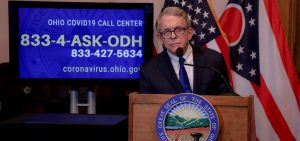News
Healthcare Workers Plead For Community Support; First County Goes Purple As COVID Surge Continues in Ohio
By: Sarah Taylor | WKSU
Posted on:
COLUMBUS, Ohio (WKSU) — For the first time since Ohio began utilizing a color-coded public health alert advisory system, a county has reached the highest level of risk. Franklin County is now at the purple level, with six of seven risk factors persisting for two straight weeks. Three other counties—Lake, Lorain and Montgomery are on the watch list to elevate to purple next week.
News of the increasing risk came as health professionals issued a plea to Ohioans during the governor’s coronavirus briefing Thursday. Erin Russo, director of Clinical Education for Memorial Health in Marysville said while they have been able to acquire equipment and supplies to fight COVID-19, “What we can’t manufacture are staff members that are skilled enough to care for those patients.”

Russo was joined by Ohio Health Vice President Cheryl Herbert and Bruce White, CEO of Knox Community Hospital in Mt. Vernon.
Herbert shared a story that she says indicates how the surge of COVID-19 cases has repercussions for all health care. A 48-year old Ohio woman who had a heart attack two days ago received care at the rural hospital near her home, but to get the advanced care necessary after her treatment, it took calls to 14 hospitals to find an available bed. “We need community support right now,” Herbert said. “We do not want to repeat her story.”
Hospital leaders say that support comes in the form of measures state and local officials are asking people to take: staying home when possible, wearing masks when going out, staying physically distanced from others, washing hands frequently and thoroughly. “They seem like minuscule tasks,” said Russo, “but to us they could make the greatest difference.”
Case numbers incomplete
Gov. DeWine said the state health department has put an asterisk on case numbers this week because it has started taking a more careful look at antigen, or rapid, COVID-19 tests. The accuracy and reliability of those tests has been questioned. DeWine said health officials have begun double-checking those. Because of that, since Monday, 12,000 of those tests have not been factored into daily case totals. The number of antigen tests being done in Ohio has increased to an average of 10,000 per day in the last week.
“We just can’t clear these cases fast enough,” DeWine said.
Daily cases increased by 7,787 Thursday but DeWine said “That number we’re reporting will be appreciably higher than that,” as those 12,000 cases are factored in. DeWine said the majority of those cases are likely to be confirmed as positive results.
Regardless of the case numbers, DeWine said the number of hospitalizations confirms the surge that’s happening. Ohio hospitals admitted 343 people in the last 24 hours with COVID-19; 8 out of 10 of the highest hospitalization days have occurred in the last 10 days, including today.
There are currently 3,829 Ohioans hospitalized with COVID-19 and 943 people in Intensive Care Units. “These are the highest patient counts we’ve had in this pandemic and more than double what we’ve seen in previous peaks,” DeWine said.
A three week curfew imposed by the governor begins tonight. It calls for people to be off the streets and most stores to close between 10 p.m. and 5 a.m.
DeWine says a retail compliance unit that has been spot-checking stores to check if people are wearing masks has visited about half the counties in the state. “They are finding about 90% compliance. We are exceedingly happy with that.”

